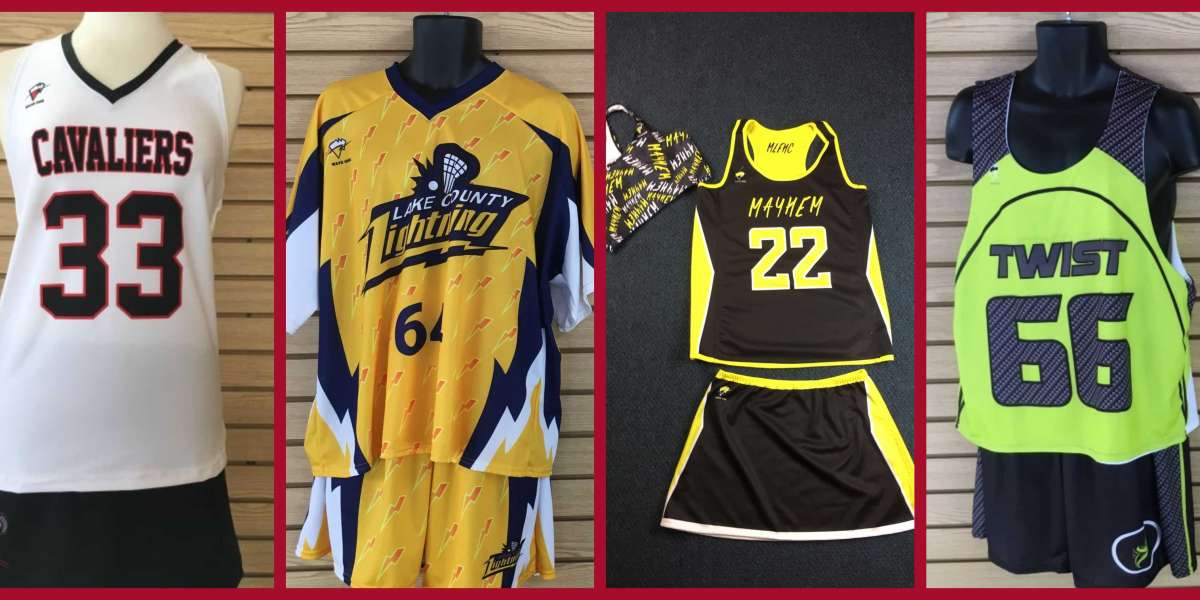In the world of sports, apparel plays a significant role in both performance and team identity. Custom sports apparel has evolved from basic uniforms to advanced, performance-enhancing gear tailored to athletes' needs. custom sports apparel teams to amateur clubs, personalized sportswear provides an opportunity to enhance team spirit, improve comfort and performance, and create a unique brand identity.
This guide explores everything you need to know about custom sports apparel, including the benefits, types of gear, customization options, and the process of creating your own designs. Whether you're looking for performance-driven clothing or stylish team uniforms, custom sports apparel can help you stand out both on and off the field.
The Importance of Custom Sports Apparel
Team Identity and Unity
Custom sports apparel fosters a sense of unity and pride within a team. It serves as a visual representation of a group’s identity, helping athletes feel part of something larger than themselves. With unique designs, team logos, and matching colors, custom apparel reinforces camaraderie and cohesion.
Performance Enhancement
Modern sports apparel is designed with performance in mind. Advances in materials and fabric technology mean that athletes can wear gear tailored to their specific needs. Custom sportswear offers features such as moisture-wicking, breathability, and flexibility, which can improve overall performance during games or workouts.
Branding and Marketing
For professional teams, sponsors, or even local clubs, custom sports apparel serves as a valuable marketing tool. Placing sponsor logos or team emblems on sportswear increases visibility, creates a professional look, and helps build a brand. Custom gear can also be sold as merchandise, generating additional revenue for teams.
Types of Custom Sports Apparel
Custom sports apparel encompasses a wide range of clothing items designed for different sports and activities. Here are some of the most common types of custom athletic wear:
Custom Jerseys and Uniforms
- Team Jerseys: The most iconic piece of sports apparel, custom jerseys are worn by teams in virtually every sport. Personalization includes player names, numbers, and team logos.
- Full Uniforms: Custom uniforms include not just jerseys, but shorts, socks, and accessories, offering a complete, cohesive look for the entire team.
Custom Activewear
- T-Shirts and Tank Tops: Custom performance shirts and tanks are ideal for training sessions and casual wear. They can be made from lightweight, moisture-wicking materials to keep athletes cool and dry.
- Compression Wear: Custom compression tops, shorts, and leggings provide muscle support, helping to reduce fatigue and improve circulation during intense physical activity.
- Hoodies and Sweatshirts: Perfect for warm-ups, custom hoodies and sweatshirts can feature team logos, slogans, or personal names. These are popular among fans as well as athletes.
Custom Outerwear
- Jackets and Windbreakers: For outdoor sports or chilly weather, custom jackets and windbreakers offer warmth and protection while showcasing the team's branding.
- Track Suits: Ideal for warm-ups or cool-downs, custom track suits provide comfort and mobility while maintaining a professional, unified team appearance.
Custom Accessories
- Hats and Caps: Custom caps, beanies, and visors can feature team logos, colors, and slogans, providing additional branding opportunities.
- Socks: Customized socks with team colors, logos, or patterns add a touch of flair to any sports uniform.
- Bags and Backpacks: Custom gear bags can be personalized with logos and names, ensuring athletes carry their gear in style while representing their team.
Fabric and Material Choices for Custom Sports Apparel
Choosing the right fabric for your custom sportswear is critical to ensuring comfort, durability, and performance. Different fabrics are suited to various sports and weather conditions, so it’s essential to consider the intended use of the apparel.
Performance Fabrics
- Polyester: Known for its durability, polyester is a popular choice for sportswear because it's lightweight, moisture-wicking, and quick-drying. It helps keep athletes cool and dry during physical exertion.
- Spandex/Lycra: Blended with other fabrics, spandex provides stretch and flexibility. It’s commonly used in compression garments, leggings, and tight-fitting activewear.
- Nylon: This durable, water-resistant fabric is used in outerwear and windbreakers. It’s also lightweight and provides excellent mobility.
- Cotton Blends: While pure cotton may absorb moisture and take longer to dry, cotton blends combine the softness of cotton with the performance benefits of synthetic fabrics like polyester or nylon.
- Moisture-Wicking Fabrics: Specially designed to draw sweat away from the skin, moisture-wicking materials are ideal for high-intensity sports. These fabrics keep athletes dry and comfortable, reducing chafing and irritation.
Weather-Appropriate Fabrics
- Fleece and Thermal Fabrics: For colder climates, fleece-lined or thermal fabrics provide insulation while maintaining breathability, making them ideal for jackets, hoodies, and winter sports gear.
- Mesh: Mesh fabrics offer excellent ventilation, making them perfect for sports like soccer, basketball, and cycling where breathability is essential.
Customization Options for Sports Apparel
Personalizing your sports apparel involves more than just choosing the right fabric and design. Here are some key customization options that allow you to create unique and stylish sportswear:
Design and Artwork
- Team Logos: Placing your team’s logo on apparel is a must for identity and branding. Logos can be printed, embroidered, or applied using heat transfer methods.
- Player Names and Numbers: Personalizing jerseys with player names and numbers is common in sports like football, basketball, and baseball. These can be applied through printing, embroidery, or heat transfer.
- Slogans and Mottos: Adding a team slogan or motivational phrase enhances team spirit and creates a sense of belonging.
- Sponsor Logos: For teams with sponsors, including their logos on uniforms and gear is essential for maintaining partnerships and increasing brand exposure.
Printing Methods
Choosing the right printing method is critical to achieving the desired look and durability. Some of the most common printing techniques include:
- Screen Printing: Ideal for larger orders, screen printing offers vibrant colors and a durable finish. It's best for simple designs with fewer colors.
- Embroidery: For a premium, professional look, embroidery adds texture and depth to logos and lettering. It is commonly used on hats, jackets, and polo shirts.
- Sublimation Printing: Perfect for all-over designs, sublimation printing transfers ink into the fabric itself, resulting in vibrant, long-lasting prints that won’t fade or crack. It's commonly used for polyester jerseys.
- Heat Transfer Vinyl: This method involves cutting designs from colored vinyl and applying them to the fabric using heat. It’s a good option for names and numbers on jerseys.
Fit and Size Options
- Standard Fit: Traditional athletic cuts that offer comfort and mobility for most body types.
- Slim Fit: More form-fitting apparel designed to reduce drag and improve aerodynamics, often used in cycling, running, or soccer.
- Custom Sizing: Some manufacturers offer customized sizing options to ensure that athletes of all shapes and sizes have a perfect fit.
The Process of Creating Custom Sports Apparel
Designing and ordering custom sportswear involves several steps, from initial planning to final production. Here’s an overview of the process:
Step 1: Define Your Needs
Before you start designing, consider the specific needs of your team or organization. Determine the type of apparel you require, the number of items, and your budget. Identify the sports or activities the apparel will be used for and whether there are any special requirements (e.g., moisture-wicking fabrics for high-intensity sports, fleece for winter wear).
Step 2: Choose a Custom Apparel Provider
Select a reputable provider with experience in producing high-quality custom sportswear. Look for companies that offer a range of customization options, including fabric choices, printing methods, and design flexibility. Check reviews, ask for samples, and ensure they have a clear, transparent ordering process.
Step 3: Design Your Apparel
Work with a designer or use online design tools provided by the apparel company to create your custom sportswear. Upload your team logo, choose colors, and decide on personalization options like player names, numbers, and sponsor logos. Most providers offer digital proofs for review before production begins.
Step 4: Place Your Order
Once you’ve finalized the design, place your order. Ensure that all details, such as sizes, quantities, and delivery timelines, are correct. Custom apparel orders typically take several weeks to complete, so plan ahead, especially if you need the gear by a specific date (e.g., the start of the season or a tournament).
Step 5: Quality Control and Delivery
After production, review the finished apparel for accuracy, quality, and fit. If everything meets your expectations, distribute the gear to your team. Ensure athletes understand the proper care instructions to maintain the durability and appearance of the custom sportswear.
Care and Maintenance of Custom Sports Apparel
To ensure your custom sports apparel lasts and maintains its appearance, proper care is essential. Here are some general guidelines:
Washing and Drying
- Wash Inside Out: Turn garments inside out to protect printed designs or embroidery.
- Use Cold Water: Cold water prevents shrinking and helps preserve the fabric and colors.
- Gentle Cycle: Use a gentle or delicate cycle for performance fabrics to prevent wear and tear.
- Avoid High Heat: Air dry or use a low-heat setting in the dryer to prevent shrinkage and damage to custom prints.



